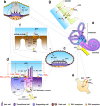Purinergic signaling in the peripheral vestibular system
- PMID: 35344126
- PMCID: PMC9123144
- DOI: 10.1007/s11302-022-09855-5
Purinergic signaling in the peripheral vestibular system
Abstract
The inner ear comprises the cochlea and vestibular system, which detect sound and acceleration stimulation, respectively. The function of the inner ear is regulated by ion transport activity among sensory epithelial cells, neuronal cells, non-sensory epithelial cells, and luminal fluid with a unique ionic composition of high [K+] and low [Na+], which enables normal hearing and balance maintenance. One of the important mechanisms regulating ion transport in the inner ear is purinergic signaling. Various purinergic receptors are distributed throughout inner ear epithelial cells and neuronal cells. To date, most studies have focused on the role of purinergic receptors in the cochlea, and few studies have examined these receptors in the vestibular system. As purinergic receptors play an important role in the cochlea, they would likely do the same in the vestibular system, which is fairly similar to the cochlea in cellular structure and function. Based on available studies performed to date, purinergic signaling is postulated to be involved in the regulation of ion homeostasis, protection of hair cells, otoconia formation, and regulation of electrical signaling from the sensory epithelium to vestibular neurons. In this review, the distribution and roles of purinergic receptors in the peripheral vestibular system are summarized and discussed.
Keywords: Inner ear; Purinergic receptors; Saccule; Semicircular canal; Utricle; Vestibular system.
© 2022. The Author(s), under exclusive licence to Springer Nature B.V.
Conflict of interest statement
Sung Huhn Kim declares that he has no conflict of interest.
Jae Young Choi declares that he has no conflict of interest.
Figures

Similar articles
-
Regulation of sodium transport in the inner ear.Hear Res. 2011 Oct;280(1-2):21-9. doi: 10.1016/j.heares.2011.05.003. Epub 2011 May 18. Hear Res. 2011. PMID: 21620939 Free PMC article. Review.
-
Extracellular nucleotide signaling in the inner ear.Mol Neurobiol. 1998 Feb;16(1):21-48. doi: 10.1007/BF02740601. Mol Neurobiol. 1998. PMID: 9554700 Review.
-
Purinergic Signaling Controls Spontaneous Activity in the Auditory System throughout Early Development.J Neurosci. 2021 Jan 27;41(4):594-612. doi: 10.1523/JNEUROSCI.2178-20.2020. Epub 2020 Dec 10. J Neurosci. 2021. PMID: 33303678 Free PMC article.
-
Evolutionary changes in the cochlea and labyrinth: Solving the problem of sound transmission to the balance organs of the inner ear.Anat Rec A Discov Mol Cell Evol Biol. 2006 Apr;288(4):482-9. doi: 10.1002/ar.a.20306. Anat Rec A Discov Mol Cell Evol Biol. 2006. PMID: 16552774 Review.
-
Hair cell specific NTPDase6 immunolocalisation in vestibular end organs: potential role of purinergic signaling in vestibular sensory transduction.J Vestib Res. 2012;22(5-6):213-9. doi: 10.3233/VES-2012-00461. J Vestib Res. 2012. PMID: 23302703
Cited by
-
Comparison Between Effects of Galvanic and Vibration-Based Vestibular Stimulation on Postural Control and Gait Performance in Healthy Participants: A Systematic Review of Cross-Sectional Studies.Ann Biomed Eng. 2024 Apr;52(4):757-793. doi: 10.1007/s10439-023-03425-5. Epub 2023 Dec 26. Ann Biomed Eng. 2024. PMID: 38148425
-
Preclinical evaluation of bozepinib in bladder cancer cell lines: modulation of the NPP1 enzyme.Purinergic Signal. 2025 Feb;21(1):39-50. doi: 10.1007/s11302-023-09975-6. Epub 2023 Oct 31. Purinergic Signal. 2025. PMID: 37906424 Free PMC article.
References
Publication types
MeSH terms
Substances
LinkOut - more resources
Full Text Sources
Research Materials

